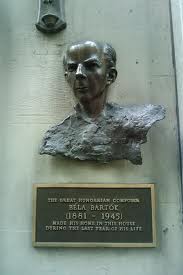 If you walk along 57th Street near Broadway, you can still see it. On the side of an ordinary-looking building, a small bronze plaque: “The great Hungarian composer Béla Bartók (1881-1945) made his home in this house during the last year of his life.”
If you walk along 57th Street near Broadway, you can still see it. On the side of an ordinary-looking building, a small bronze plaque: “The great Hungarian composer Béla Bartók (1881-1945) made his home in this house during the last year of his life.”
Each time I pass this spot, I think of the man who, dying of leukemia in a tiny apartment, far from his beloved Hungary, composed this surprisingly positive concerto during the summer of 1945. He wrote it as a birthday gift for his wife, the pianist Ditta Pásztory Bartók. It is likely that he hoped it would provide her with some income after his death. Bartók completed all but the last seventeen bars himself; these last measures were orchestrated by his composer-friend Tibor Serly, based on Bartók’s sketches.
It is easy to hear the second movement (Adagio religioso) as a response to Bartók’s own illness. True or not, there is one other quite definite reference: to Beethoven’s string quartet in A-minor, op. 132, which he composed after a serious illness.
Profoundly beautiful as the concerto’s second movement is, the gracefulness of the first and the impetuous energy of the third are equally compelling. This is about as far from death-haunted music as one can get. I hear it in my mind everytime I’m on 57th Street, and I’m always astonished.
Piano Concerto No. 3
Composed in 1945
By Bela Bartok






